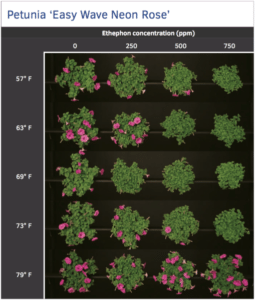
Enhancing Your PGR Applications — Part 2
View Enhancing Your PGR Applications — Part 1: How does spray water alkalinity affect the efficacy of commonly used plant growth regulators?
Greenhouse average daily temperature (ADT) plays a large role in the rate of plant development such as time to flower. Generally, as the ADT increases from the base to the optimum temperature, developmental rate increases. As temperatures increase beyond the optimum, development is hindered.
The question many growers are asking is, “How does the ADT at application influence plant growth retardant (PGR) applications?” In this second article of a two-part series on how to increase PGR efficacy, we will share the results of two experiments conducted at Michigan State University (MSU) investigating how air temperature at application affects the efficacy of two commonly used PGRs [ethephon and paclobutrazol (PBZ)].
Study 1 – Ethephon

To understand the results of this study, it is helpful to understand how ethephon works. As mentioned in the first article in the November issue of GPN, ethephon is mixed with carrier water and is sprayed in a liquid form. As ethephon changes to ethylene, it changes state from a liquid to a gas. If this change occurs before the plant absorbs ethephon, the ethylene is released into the air. If ethephon is absorbed and changes inside the plant, efficacy is increased. The last article elaborated on how carrier water alkalinity and thus solution pH impacts this change, while this article focuses on the effect of air temperature at application.
In this study we evaluated four ethephon (Collate, Fine Americas, Inc.) concentrations [0 (control), 250, 500 or 750 ppm] on petunia ‘Easy Wave Neon Rose’, ivy geranium ‘Precision Pink’ and verbena ‘Aztec Blue Velvet’; at five application ADTs (constant day and night greenhouse temperatures set points of 57, 63, 69, 73 or 79° F). The plugs and liners were transplanted into 4-inch containers and grown in a glass-glazed greenhouse at a constant 68° F and irrigated as needed with a constant 125-ppm nitrogen. Sprays were initiated seven (verbena and ivy geranium) or 14 (petunia) days after transplant without a surfactant at a rate of 0.5 gallons/100 square feet.
On the day of foliar spray applications, plants were transferred to greenhouse compartments with ADTs of 57, 63, 69, 73 or 79° F. After 24 hours, plants were transferred back to 68° F as ethephon takes ~12 hours to be fully absorbed into the plant.
Ethephon Findings

to compartments with ambient air temperatures of 57, 63, 69, 73 or 79° F for 24 hours and concentrations of ethephon at 0, 250, 500 or 750 ppm with a carrier water alkalinity of 150 ppm were applied. Photo taken six weeks after transplant.
Greenhouse air temperature had a large impact on the efficacy of ethephon. For example, ivy geranium sprayed with 750-ppm ethephon at an air temperature set-point of 73° F flowered 62 days after transplant. When ivy geranium was sprayed with the same rate of ethephon at 79° F, plants flowered in 41 days, similar to the plants not sprayed with ethephon (Figure 1).
Additionally, ivy geranium sprayed with 750-ppm ethephon at an air temperature of 79° F were 1.3 inches taller and had 10 less inflorescences per plant at flowering than those sprayed with 750 ppm with an air temperature of 73° F. Similarly, petunia flowered seven days faster and had 35 less branches at first open flower when sprayed with 500 ppm ethephon at an air temperature of 79° F compared to 73° F (Figure 2). Verbena flowered 22 days faster, and at flowering had 2.4-inch shorter stems and 30 fewer branches at first open flower when sprayed with 750-ppm ethephon in an air temperature of 79° F compared to 73° F.
In general, for all three species, as temperatures at application increased from 57 to 73° F, the sprays were effective at influencing extension growth, aborting flowers and promoting lateral branching. As temperature increased from 73 to 79° F, efficacy was significantly reduced as plants flowered faster, had fewer branches and more stem elongation.
Study 2 – Paclobutrazol
In this study, we evaluated four PBZ (Piccolo, Fine Americas) concentrations [0 (control), 15, 30 or 45 ppm] on geranium ‘Pinto Premium Deep Red’, petunia ‘Prostrate Wave Purple Improved’, marigold ‘American Inca II Yellow’ and pineapple mint ‘Blackie’ at three ADTs (constant day and night greenhouse temperatures set points of 60, 72 or 82° F).
Plugs of the four species were received from a commercial greenhouse (C. Raker & Sons, Litchfield, Michigan) and were then transplanted into 4-inch containers and grown at a constant 68° F greenhouse until roots reached the edge of the containers. At that time, the PBZ treatments were applied as foliar sprays without a surfactant at 0.5 gallon/100 square feet, and plants were moved to greenhouse compartments with ADTs stated above and remained there for the rest of the study. All plants were irrigated by hand as needed with a constant 125-ppm nitrogen liquid feed.
Plant height and two widths (one at the widest portion of the plant and the second perpendicular to that) were measured each week on each plant until all plants were in flower. Growth index was calculated as (plant height + plant width 1 + plant width 2)/3 to represent the size of the plant. At the end of the study, shoot dry weight was determined by harvesting, drying and weighing the above-ground portion of all plants.

Paclobutrazol Findings
Geranium was the only species impacted by ADT, PBZ concentration, and their interaction for both GI and DW, which indicates that, at least for this species, the effectiveness of PBZ depended upon the ADT. The effect of PBZ was most pronounced at cooler temperatures compared to warmer temperatures (Figure 3). For instance, the growth index of geranium was 19 to 30 percent lower than the control at the cooler temperature (60° F) and only 12 to 14 percent lower at the higher temperature (82° F). At cooler temperatures, the shoot dry weight of geranium was 23 to 48 percent lower than the control while it was only up to 6 percent lower for warmer temperatures.
However, for the other species, the efficacy of PBZ was not influenced by temperature. For example, petunia showed only minor reductions in growth at cooler temperatures and no reductions at higher temperatures (Figure 4). One potential reason we observed minor effects of PBZ and the interaction of ADT and PBZ on marigold, petunia, and pineapple mint is that the concentration of PBZ may not have been high enough. This study used PBZ concentrations ranging from 15 to 45 ppm, which encompassed most of the recommended PBZ spray concentration ranges for the four species tested here. However, either higher concentrations or repeated or earlier applications of PBZ may be needed for vigorous cultivars.

Take Home Message
For maximum efficacy, ethephon spray applications should be made when ambient greenhouse temperatures are at or below 73° F. Since it takes ~12 hours to be absorbed, consider spraying in the evening when both solar radiation and air temperatures are reduced. Higher concentrations of PBZ may need to be applied when greenhouse temperatures are warmer.
Also, be aware of “hot spots” in your greenhouse where temperatures maybe higher as these may lead to a non-uniform efficacy and crops.
Always preform in-house trials to evaluate the effectiveness of PGRs on plants produced under your growing conditions (i.e. temperatures, light levels and humidity).


 Video Library
Video Library 




















